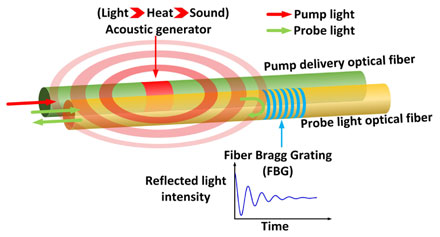An all-fiber-optics-based system for monitoring structure health shows promise as a reliable means to oversee structural soundness under extreme conditions. Active ultrasonic nondestructive evaluation (NDE), currently a widely used technique in structural health monitoring, has traditionally employed piezoelectric transducers (PZTs), which can be of limited use in corrosive environments or under extremely high temperatures.

The principle of operation for a single all-fiber-optics-based
multiparameter structure-health-monitoring (AFO-SHM) sensing node.
Courtesy of OSA, the Optical Society.
Driven by the need for an ultrasonic NDE system that is more compact, multiplexable, and capable of working in harsh environments, researchers have studied the possibilities of using fiber optic technologies in ultrasonic NDE. One approach has been to use optical fibers to replace the PZTs in the traditional NDE system as broadband ultrasonic sources or broadband detectors.
Researchers at Virginia Tech have designed, fabricated and demonstrated a multiplexable, all-fiber-optics-based system, which is known as an all-fiber-optics-based multiparameter structure-health-monitoring (AFO-SHM) network.
The system uses two optical fibers to serially connect multiple active fiber-optic nondestructive evaluation (FO-NDE) elements, which are attached to the surface of the structure that is being monitored. Each sensing element consists of an acoustic-generation unit and an acoustic-detection unit.
The acoustic-generation unit is a micro structure fabricated in a multimode fiber, which serves to scatter light out of the optical fiber. The scattered light generates acoustic vibration on the surrounding material through a thermal-elastic effect. A consistent acoustic emission strength at different nodes can be achieved by the gradual increase of the scattering ratio of each node. The acoustic-detection unit is a 2-mm fiber Bragg grating (FBG) in a single-mode fiber, which detects the dynamic strain on the optical fiber. The vibrations are received by the FBG; and the FBG forms the acoustic signature of the structure. The FBG also provides information about the strain and temperature of the structure.
The serially connected FBGs in the AFO-SHM network are fabricated with different center wavelengths. To obtain the acoustic signal of a certain sensing node, the wavelength of the probe light is tuned to the full width half maximum (FWHM) wavelength of the FBG in that node. By switching the probe light wavelength through all the FBGs in the network, multiplexed acoustic detection can be achieved.
The researchers demonstrated the system on an aluminum test piece, monitoring temperature, strain and thickness changes, and quantitatively associating the changes with the FBG spectrum shift and the peak shifts in the acoustic signature. The multiplexing capability was demonstrated by the acquisition of spectrum information and acoustic signatures from an AFO-SHM network containing two cascaded nodes.
“By analyzing the acoustic signature of the structure and the additional information from FBG, we can simultaneously monitor multiple environment parameters,” researcher Chennan Hu said.
For their demonstration, the researchers used a temperature range from 24 °C to 60 °C, which is the allowed working temperature of the epoxy used in the AFO-SHM node.
The research did not demonstrate monitoring under high temperatures, “but we believe that this system could be used in high temperature when the low-temperature epoxy is replaced by high-temperature adhesive, and we have already acquired promising high-temperature monitoring results,” Hu said.
One possible application of the distributed sensing system could be on the outer surface of P91 pipes, which are widely used in the power industry.
“These pipes are usually used to transmit corrosive high-temperature, high-pressure steam,” Hu explained. “However, the integrity of these pipes and other critical materials involved in a power-generation system may deteriorate over time and the deterioration rate may pick up rapidly as the system operating temperature is pushed higher, so monitoring of these materials becomes more important.”
The sensor system also could be used on an aircraft to monitor the health of multiple points in the gas turbine engine or other critical parts.
Next, the research team plans to develop a compact and robust sensor system and field-test the system in a real power plant, then adapt their technology for commercial use.
“Fiber optic components have been demonstrated to work reliably under very high temperatures because of the simplicity of the optical fiber material — fused silica — that forms the fiber,” said Hu. “The development of this fiber-optics technology would significantly enhance the monitoring of the health conditions of critical infrastructures operating under harsh environments, such as modern superheaters or nuclear power plants. It will thus help ensure the continuous operation of power plants and help prevent the catastrophic consequences of possible structural failures.”
The research was published in Optics Express, a journal of OSA, the Optical Society of America (doi: 10.1364/OE.24.020287).